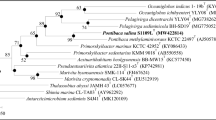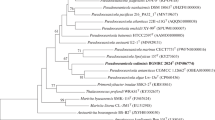Abstract
A novel bacterium designated A3.4T was isolated from the beach sediment of Zhairuo Island, which is located in the East China Sea. Strain A3.4T was found to be Gram-stain negative, cream coloured, rod-shaped, aerobic and motile via a single monopolar flagellum. The isolate grows at 20–37 °C (optimum 25–30 °C), at pH 6.0–8.0 (optimum pH 7.0–8.0), and in the presence of 0–5.0% (w/v) NaCl (optimum 0.5–1%). A3.4T has catalase and oxidase activity. The predominant fatty acids (≥ 10%) of the strain were identified as C16:0, summed feature 3 (C16:1 ω7c /C16:1 ω6c) and summed feature 8 (C18:1 ω7c /C18:1 ω6c). Q-9 was identified as the major isoprenoid quinone, with trace levels of Q-8 present. The major polar lipids were identified as diphosphatidylglycerol, phosphatidylethanolamine and phosphatidylglycerol. The draft genome size is 3.55 Mb, with a DNA G + C content of 57.7 mol%. Analysis of the 16S rRNA gene sequence of strain A3.4T indicates that it belongs to the genus Atopomonas and shares high sequence similarity with Atopomonas hussainii JCM 19513T (97.60%). This classification was also supported by phylogenetic analysis using rpoB and several core genes. The genome of strain A3.4T shows an average nucleotide identity of 82.3%, an amino acid identity of 83.0%, and a digital DNA–DNA hybridization value of 22.1% with A. hussainii. In addition, 20 conserved signature indels (CSIs) were identified to be specific for A3.4T and A. hussainii, demonstrating that the strain A3.4T is closely related to A. hussainii rather than other species of family Pseudomonadaceae. Hundreds of unique genes were identified in the genomes of A3.4T and A. hussainii, which may underly multiple phenotypic differences between these strains. Based on phenotypic, chemotaxonomic, phylogenetic, and genomic investigations, strain A3.4T is concluded to represent a novel species of the genus Atopomonas, for which the name Atopomonas sediminilitoris sp. nov. is proposed. The type strain is A3.4T (= LMG 32563T = MCCC 1K07166T).


Similar content being viewed by others
References
Altschul SF, Gish W, Miller W et al (1990) Basic local alignment search tool. J Mol Biol 215:403–410
Anwar N, Abaydulla G, Zayadan B et al (2016) Pseudomonas populi sp. nov., an endophytic bacterium isolated from populus euphratica. Int J Syst Evol Microbiol 66:1419–1425
Bankevich A, Nurk S, Antipov D et al (2012) SPAdes: a New Genome Assembly Algorithm and Its Applications to Single-Cell Sequencing. J Comput Biol 19:455–477
Blin K, Shaw S, Steinke K et al (2019) antiSMASH 5.0: updates to the secondary metabolite genome mining pipeline. Nucleic Acid Res 47:W81–W87
Chun J, Oren A, Ventosa A et al (2018) Proposed minimal standards for the use of genome data for the taxonomy of prokaryotes. Int J Syst Evol Microbiol 68:461–466
Debnath SC, Chen C, Liu S-X et al (2019) Flavobacterium sharifuzzamanii sp. nov., Isolated from the Sediments of the East China Sea. Curr Microbiol 76:297–303
Felsenstein J (1981) Evolutionary trees from DNA sequences: a maximum likelihood approach. J Mol Evol 17:368–376
Fox GE, Wisotzkey JD, Jurtshuk P (1992) How close is close: 16S rRNA sequence identity may not be sufficient to guarantee species identity. Int J Syst Bacteriol 42:166–170
Frank JA, Reich CI, Sharma S et al (2008) Critical evaluation of two primers commonly used for amplification of bacterial 16S rRNA genes. Appl Environ Microbiol 74:2461–2470
Glaeser SP, Kämpfer P (2015) Multilocus sequence analysis (MLSA) in prokaryotic taxonomy. Syst Appl Microbiol 38:237–245
Gupta RS (2014) Chapter 8–identification of conserved indels that are useful for classification and evolutionary studies. In: Goodfellow M, Sutcliffe I, Chun J (eds) methods in microbiology. Academic Press, pp 153–182
Hameed A, Shahina M, Lin S-Y et al (2014) Pseudomonas hussainii sp. nov., isolated from droppings of a seashore bird, and emended descriptions of pseudomonas pohangensis, pseudomonas benzenivorans and pseudomonas segetis. Int J Syst Evol Microbiol 64:2330–2337
Hesse C, Schulz F, Bull CT et al (2018) Genome-based evolutionary history of pseudomonas spp. Environ Microbiol 20:2142–2159
Jain C, Rodriguez-R LM, Phillippy AM et al (2018) High throughput ANI analysis of 90K prokaryotic genomes reveals clear species boundaries. Nat Commun 9:5114
Kamlage B (1996) Methods for general and molecular bacteriology. edited by P. Gerhardt, R. G. E. Murray, W. A. Wood and N. R. Krieg. 791 pages, numerous figures and tables. American Society for Microbiology, Washington, D.C., 1994. Food Nahr 40:103–103
Kim J, Na SI, Kim D et al (2021) UBCG2: up-to-date bacterial core genes and pipeline for phylogenomic analysis. J Microbiol 59:609–615
Kimura M (1980) A simple method for estimating evolutionary rates of base substitutions through comparative studies of nucleotide sequences. J Mol Evol 16:111–120
Komagata K, Suzuki K-I (1988) 4 lipid and cell-wall analysis in bacterial systematics. In: Colwell RR, Grigorova R (eds) methods in microbiology. Academic Press, pp 161–207
Li W, O’Neill KR, Haft DH et al (2021) RefSeq: expanding the prokaryotic genome annotation pipeline reach with protein family model curation. Nucleic Acid Res 49:D1020–D1028
Macián M, Arahal D, Garay E et al (2005) Thalassobacter stenotrophicus gen. nov., sp. nov., a novel marine α-proteobacterium isolated from mediterranean sea water. Int J Syst Evol Microbiol 55:105–110
Meier-Kolthoff JP, Auch AF, Klenk H-P, Göker M (2013) Genome sequence-based species delimitation with confidence intervals and improved distance functions. BMC Bioinform 14:60
Minnikin DE, Odonnell AG, Goodfellow M et al (1984) An integrated procedure for the extraction of bacterial isoprenoid quinones and polar lipids. J Microbiol Method 2:233–241
Raghunath P (2014) Roles of thermostable direct hemolysin (TDH) and TDH-related hemolysin (TRH) in Vibrio parahaemolyticus. Front Microbiol 5:805
Richter M, Rosselló-Móra R (2009) Shifting the genomic gold standard for the prokaryotic species definition. Proc Natl Acad Sci U S A 106:19126–19131
Rodriguez-R LM, Konstantinidis KT (2014) Bypassing cultivation to identify bacterial species. Microbe 9:111–118
Rudra B, Gupta RS (2021) Phylogenomic and comparative genomic analyses of species of the family Pseudomonadaceae: proposals for the genera Halopseudomonas gen. nov. and Atopomonas gen. nov., merger of the genus Oblitimonas with the genus Thiopseudomonas, and transfer of some misclassified species of the genus Pseudomonas into other genera. Int J Syst Evol Microbiol 71 9 005011
Saitou N, Nei M (1987) The neighbor-joining method: a new method for reconstructing phylogenetic trees. Mol Biol Evol 4:406–425
Sasser M (1990) Identification of bacteria by gas chromatography of cellular fatty acids. USFCC Newsl 20:1–6
Sethi D, Mahajan S, Singh C et al (2016) Lipoprotein LprI of mycobacterium tuberculosis acts as a lysozyme inhibitor*. J Biol Chem 291:2938–2953
Sofi MY, Shafi A, Masoodi KZ (2022) Chapter 8–CLUSTALW software. In: Sofi MY, Shafi A, Masoodi KZ (eds) bioinformatics for everyone. Academic Press, pp 75–84
Sudan SK, Pal D, Bisht B et al (2018) Pseudomonas fluvialis sp. nov., a novel member of the genus Pseudomonas isolated from the river Ganges. India Int J Syst Evol Microbiol 68:402–408
Xia X (2018) Maximum parsimony method in phylogenetics. In: Xia X (ed) Bioinformatics and the cell: modern computational approaches in genomics, proteomics and transcriptomics. Springer International Publishing, Cham, pp 327–341
Ye Y, Chen C, Ren Y et al (2019) Pseudomonas mangrovi sp. nov., isolated from mangrove soil. Int J Syst Evol Microbiol 69:377–383
Yoon S-H, Ha S-M, Kwon S et al (2017) Introducing EzBioCloud: a taxonomically united database of 16S rRNA gene sequences and whole-genome assemblies. Int J Syst Evol Microbiol 67:1613–1617
Yu X-Y, Zhai J-Y, Wu C et al (2018) Pseudomonas pharmafabricae sp. nov., isolated from pharmaceutical wastewater. Curr Microbiol 75:1119–1125
Acknowledgements
We thank Dr. Xu Youping (Analysis Center of Agrobiology and Environmental Sciences, Faculty of Agriculture, Life and Environment Sciences, Zhejiang University) for fatty acid analysis. We also thank the equipment support of the Field Scientific Observation and Research Station of Ministry of Education of Marine Ecosystem in Zhoushan Islands, Zhejiang Province.
Funding
This study was supported by a grant from the National Key research and development Program of China (2021YFA0909500), Fundamental Research Funds for the Central Universities (2021XZZX018), and the National Natural Science Foundation of China Grants (32022004 and 32170078).
Author information
Authors and Affiliations
Contributions
Sanjit Chandra Debnath isolated the bacterium; Kejing Li performed the phenotypic and biochemical experiments, analysed the data, and drafted the manuscript; Zhenbo Ye, Gen Chen, Kaiwen Zheng, Jun Yin, Cen Yan, Yi Hong and Zhen Guo provided supports during the experiments performing and data analysis; Daoqiong Zheng, Fabai Wu and Pinmei wang designed and supervised the study and edited the original draft.
Corresponding authors
Ethics declarations
Conflicts of interest
The authors declare that there are no conflicts of interest.
Ethical approval
This study does not describe any experimental work related to humans.
Additional information
Publisher's Note
Springer Nature remains neutral with regard to jurisdictional claims in published maps and institutional affiliations.
Supplementary Information
Below is the link to the electronic supplementary material.
Rights and permissions
Springer Nature or its licensor holds exclusive rights to this article under a publishing agreement with the author(s) or other rightsholder(s); author self-archiving of the accepted manuscript version of this article is solely governed by the terms of such publishing agreement and applicable law.
About this article
Cite this article
Li, K., Ye, Z., Chen, G. et al. Atopomonas sediminilitoris sp. nov., isolated from beach sediment of Zhairuo Island, China. Antonie van Leeuwenhoek 116, 97–107 (2023). https://doi.org/10.1007/s10482-022-01780-2
Received:
Accepted:
Published:
Issue Date:
DOI: https://doi.org/10.1007/s10482-022-01780-2




